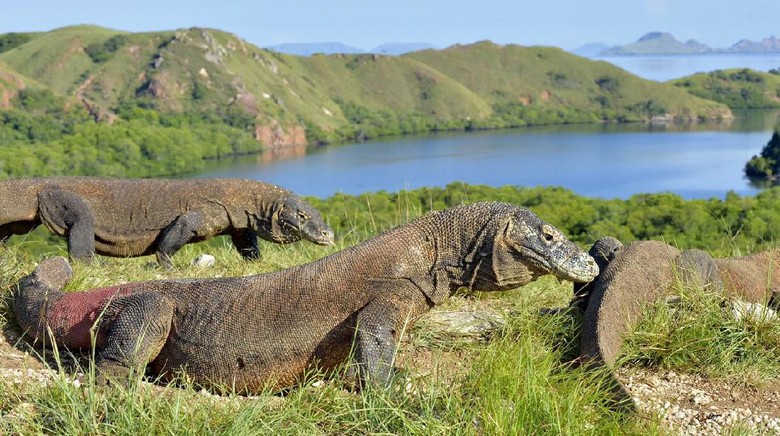Komodo Island is one of 7 Wonders of the World (2011 voting results). The Komodo National Park consists of 3 large islands, Komodo Island, Rinca Island, and Padar Island, as well as other smaller islands. The area of this national park as a whole is 1,817Km2.
Komodo Island is located at the westernmost tip of East Nusa Tenggara Province. On the island of Komodo, Komodo animals live and breed well, according to data, until mid-2009, the island is inhabited by about 1300 tails of Komodo dragons (+/- 2500 tails on all islands in TM. Komodo). Komodo is the world's largest lizard species, with an average length of 2-3 meters, and a body weight of at least 90 kg.
Komodo National Park which consists of islands is certainly separated by the sea. Underwater life here is no less beautiful. You can find 385 species of beautiful corals, 70 types of sponges, 10 types of dolphins, 6 kinds of whales, green turtles, various types of sharks, and stingrays.
:strip_icc():format(jpeg)/kly-media-production/medias/2522094/original/073842700_1544551798-Komodo_3.JPG)
While on Komodo Island, many things can be done. Therefore, make sure that your body is fit and strong enough to get around the island. On this island you are invited to trek along the path that has been designed and safe. On Komodo Island, you have to climb Mount Ara as high as 538 m above sea level for 3 or 4 hours.
On Rinca Island, you have to do trekking for 1.5 hours. If you are lucky, you can see dragons that are attacking their prey, fighting, or walking slowly along the road. So curious about this island? The following facts must be known before visiting Komodo Island.
The Komodo National Park was declared a World Heritage Site and Man and Biosphere Reserve by UNESCO in 1986.
The longest recorded Komodo dragon is 3.13 meters with a weight of 166 kg. It has 60 sharp jagged teeth about 2.5 cm long, which are often replaced.
Komodo dragon's saliva is often mixed with a little blood because its teeth are almost completely covered by gingival tissue and this tissue is torn during eating. This condition creates an ideal growth environment for deadly bacteria that live in their mouths.
The male Komodo dragon is bigger than the female Komodo dragon, with skin color from dark gray to brick red, while the female Komodo dragon is more olive green, and has a small yellow stripe on its throat. Young Komodo dragons are more colorful, with yellow, green and white on a black background.
The most deadly bacteria in Komodo dragon's saliva seems to be the bacterium Pasteurella multocida.
The mating season occurs in May and August. Contain eggs for a month, and eggs will hatch in 7-8 months. A female Komodo dragon can lay eggs up to 13 points.
The Komodo National Park was declared a World Heritage Site and Man and Biosphere Reserve by UNESCO in 1986.
The longest recorded Komodo dragon is 3.13 meters with a weight of 166 kg. It has 60 sharp jagged teeth about 2.5 cm long, which are often replaced.
Komodo dragon's saliva is often mixed with a little blood because its teeth are almost completely covered by gingival tissue and this tissue is torn during eating. This condition creates an ideal growth environment for deadly bacteria that live in their mouths.
The male Komodo dragon is bigger than the female Komodo dragon, with skin color from dark gray to brick red, while the female Komodo dragon is more olive green, and has a small yellow stripe on its throat. Young Komodo dragons are more colorful, with yellow, green and white on a black background.
The most deadly bacteria in Komodo dragon's saliva seems to be the bacterium Pasteurella multocida.
The mating season occurs in May and August. Contain eggs for a month, and eggs will hatch in 7-8 months. A female Komodo dragon can lay eggs up to 13 points.
Tags:
nature

